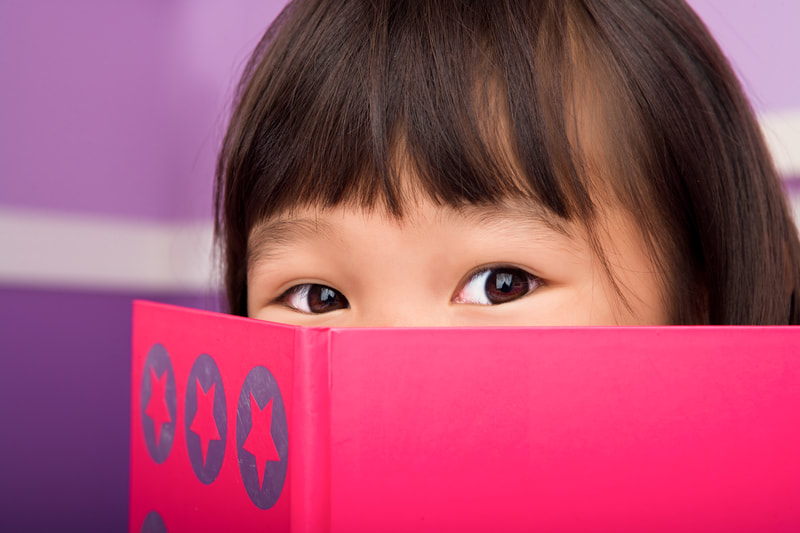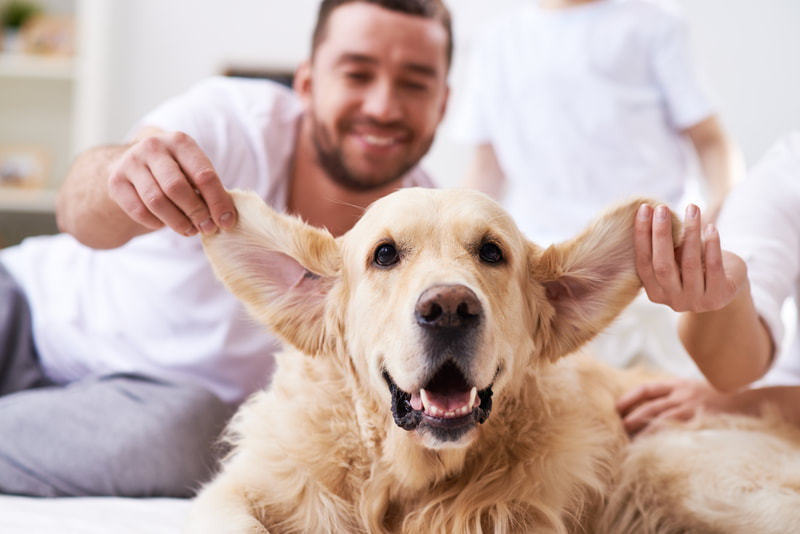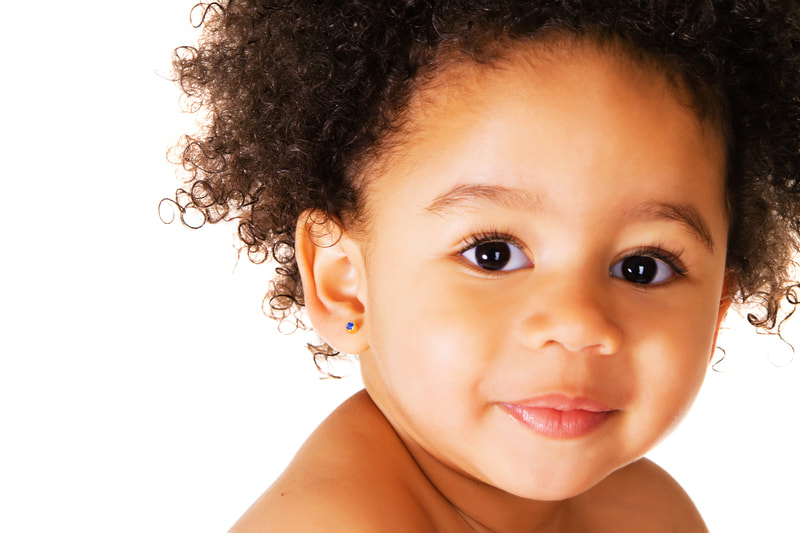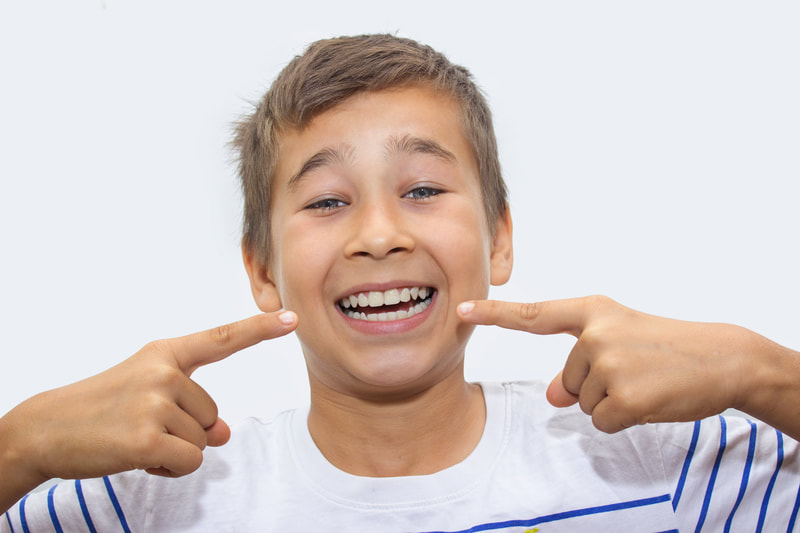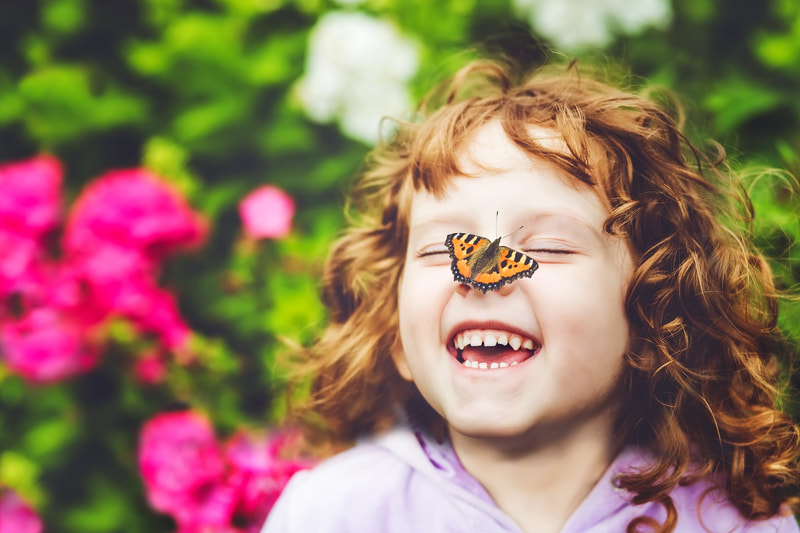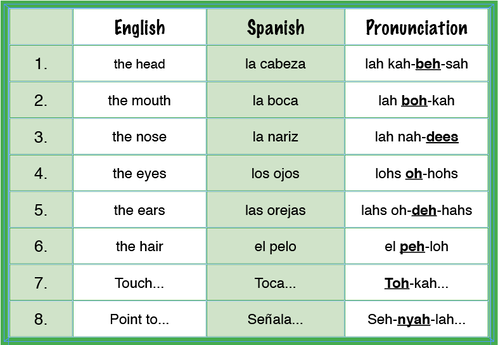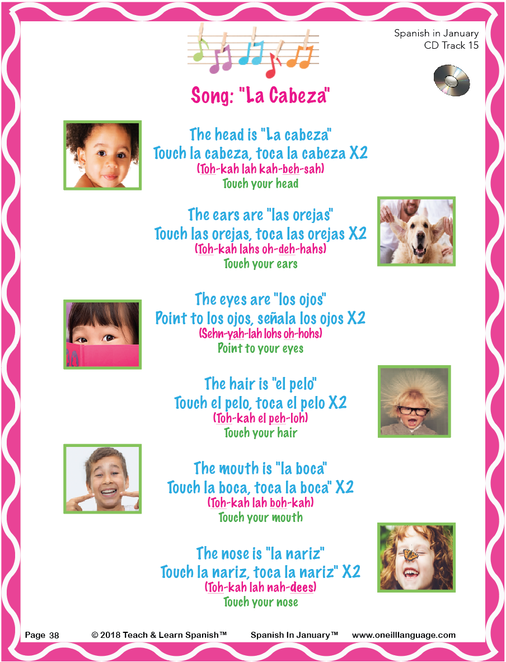|
the eyes: los ojos (lohs oh-hohs)
|
Lesson: Learning Head and Face Vocabulary
Have fun with all of the activities below that will turn you and your children into experts at understand and saying the parts of the head and face in Spanish!
Materials Needed:
Six pictures of the face and head. You can click on the pdf below to download them and print them off or you can use the pictures displayed below.
Six pictures of the face and head. You can click on the pdf below to download them and print them off or you can use the pictures displayed below.
| head_and_face_visuals.pdf | |
| File Size: | 4567 kb |
| File Type: | |
Parent Preparation: Watch the Parent Learning and Teaching Videos
The Parent Learning Video teaches you how to pronounce the parts of the head and face. You want to feel confident pronouncing the words before teaching them to your children. As you're watching the video, look at the page to the right entitled "Head and Face Vocabulary". This page is your "cheat-sheet". See how each word is written in English followed by Spanish and there's a pronunciation key to the right of each word? Read the pronunciation key as though you're reading English and your pronunciation will be spot-on! Be sure to stress the syllables that are in bold and underlined. We try to make everything as simple as possible when it comes to families learning Spanish!
When you feel confident pronouncing the words, watch the Teaching Video which walks you through how you're going to teach the head and face vocabulary to your children!
The Parent Learning Video teaches you how to pronounce the parts of the head and face. You want to feel confident pronouncing the words before teaching them to your children. As you're watching the video, look at the page to the right entitled "Head and Face Vocabulary". This page is your "cheat-sheet". See how each word is written in English followed by Spanish and there's a pronunciation key to the right of each word? Read the pronunciation key as though you're reading English and your pronunciation will be spot-on! Be sure to stress the syllables that are in bold and underlined. We try to make everything as simple as possible when it comes to families learning Spanish!
When you feel confident pronouncing the words, watch the Teaching Video which walks you through how you're going to teach the head and face vocabulary to your children!
|
Parent Learning Video
|
Head and Face Vocabulary
|
|
Parent Teaching Video
|
|
Activities To Do with Your Children
|
1. Touch the Pictures
Start with some suspense. Hold the six pictures facing you so your kids cannot see them. One at a time describe the picture with excitement so that you build suspense. For example tell your kids that you have a super silly picture of a boy with really crazy hair. Laugh as you tell them. Then ask them if they want to see it.
After you have described each picture and shown them to your children, lay tape them to the wall or lay them all on the floor or a table. Then in Spanish have your kids take turns “touching” the pictures you name. Remember that the command “touch" in Spanish is “toca” (pronounced: toh-kah). So if you say, “Toca las orejas,” they should touch the picture of the ears. If they get it wrong, give them another chance and guide them to touch the correct picture. Your goal is for them to be successful. Kids love to repeat what they are good at so help them become good at this activity! Require older kids to repeat the name of the pictures as they touch them! If you have a wand, a light saber or a new flyswatter, let them use it to touch or swat the pictures. It makes the activity more exciting for them!
Start with some suspense. Hold the six pictures facing you so your kids cannot see them. One at a time describe the picture with excitement so that you build suspense. For example tell your kids that you have a super silly picture of a boy with really crazy hair. Laugh as you tell them. Then ask them if they want to see it.
After you have described each picture and shown them to your children, lay tape them to the wall or lay them all on the floor or a table. Then in Spanish have your kids take turns “touching” the pictures you name. Remember that the command “touch" in Spanish is “toca” (pronounced: toh-kah). So if you say, “Toca las orejas,” they should touch the picture of the ears. If they get it wrong, give them another chance and guide them to touch the correct picture. Your goal is for them to be successful. Kids love to repeat what they are good at so help them become good at this activity! Require older kids to repeat the name of the pictures as they touch them! If you have a wand, a light saber or a new flyswatter, let them use it to touch or swat the pictures. It makes the activity more exciting for them!
|
2. Play Song "La Cabeza" Audio File (To play the audio file, click on the small gray triangle.) |
Tell your kids they are going to touch different parts of their own heads while singing the song called “La Cabeza,” which means “The Head” (pronounced: Lah Kah-beh-sah). See the song lyrics below. Play Spanish In January CD Track 15. Follow the commands in the song. The more dramatic and excited you are when following the commands in the song, the more motivated your kids will be!
The second or third time you listen to and act out the song, change things up. Have your kids sit facing a sibling. This time their goal is to very gently touch the parts of their sibling's head as they listen to and sing the song. One sibling goes first, then the other. To make things a bit silly, play the song again and they both try to touch the parts on each other's heads at the same time.
The second or third time you listen to and act out the song, change things up. Have your kids sit facing a sibling. This time their goal is to very gently touch the parts of their sibling's head as they listen to and sing the song. One sibling goes first, then the other. To make things a bit silly, play the song again and they both try to touch the parts on each other's heads at the same time.
Here are the lyrics to the song:
3. Watch the Video for Kids!
Your children will surly love watching this video because our friend "Pollo" which means "Chicken" in Spanish and my dog "Oso" which means "Bear" in Spanish help to teach the parts of the head and face in Spanish. Play this video over and over, as long as your children are excited to watch it. This will build their listening comprehension.
Your children will surly love watching this video because our friend "Pollo" which means "Chicken" in Spanish and my dog "Oso" which means "Bear" in Spanish help to teach the parts of the head and face in Spanish. Play this video over and over, as long as your children are excited to watch it. This will build their listening comprehension.
Video for Kids!
4. Game: Simon Says
Play the popular children's game "Simon Says...," which in Spanish translates as “Simón Dice...” (pronounced: See-mohn Dee-seh).
Everyone should begin standing up. The leader gives a series of commands telling everyone to touch parts of their head. Every time the leader precedes a command with the expression, “Simón dice” the players must touch that part of their head. When the leader does not precede a command with “Simón dice,” the players should NOT touch that part of their head. They should keep their hands by their side. The leader carries through with every command to try to trick everyone. If the players touch a part of their head when they shouldn't, or if they don't touch a part of their head when they should, they sit down for the remainder of that game. The last child standing wins. This is a wonderful filler activity for anytime of the day!
Grammar Note:
You say "Toquen" (pronounced: Toh-ken) to more than one person.
You say "Toca" (pronounced: Toh-kah) to one person.
Examples:
Examples of what the leader can say:
"Simón dice, toquen la nariz."
"Simón dice, toquen las orejas."
"Toquen la boca." (Anyone who touches their mouth must sit down.)
Play the popular children's game "Simon Says...," which in Spanish translates as “Simón Dice...” (pronounced: See-mohn Dee-seh).
Everyone should begin standing up. The leader gives a series of commands telling everyone to touch parts of their head. Every time the leader precedes a command with the expression, “Simón dice” the players must touch that part of their head. When the leader does not precede a command with “Simón dice,” the players should NOT touch that part of their head. They should keep their hands by their side. The leader carries through with every command to try to trick everyone. If the players touch a part of their head when they shouldn't, or if they don't touch a part of their head when they should, they sit down for the remainder of that game. The last child standing wins. This is a wonderful filler activity for anytime of the day!
Grammar Note:
You say "Toquen" (pronounced: Toh-ken) to more than one person.
You say "Toca" (pronounced: Toh-kah) to one person.
Examples:
Examples of what the leader can say:
"Simón dice, toquen la nariz."
"Simón dice, toquen las orejas."
"Toquen la boca." (Anyone who touches their mouth must sit down.)
|
5. Game: Who Finds It First? Juego: ¿Quién lo Encuentra Primero?
(Hweh-goh: ¿Kee-en loh En-kwen-tdah Pdee-meh-doh?) Have your children close their eyes and count to ten with you in Spanish as you hide one of the head or face pictures somewhere in the room. Tell them to open their eyes. On a piece of white paper draw a picture of the part of the head or face that you hid. The kids have to guess what you are drawing in Spanish. "la cabeza", "la nariz", etc. When they guess the right word, tell them "Yes" in Spanish which is "Sí", pronounced "See". At that moment they all get to stand up and look for the hidden picture. As they are looking for the picture, lead your kids in chanting the word out loud. Don't stop chanting until someone finds it. The child who finds the picture should bring it back to you. Continue playing until each child has had a turn to hide picture and draw. If you want to play with teams, make a second copy of the pictures. Hide one picture on Team A's side of the room and one picture on Team B's side of the room. The first team to find their picture down gets two points and the second team one point. Add up the points at the end and announce how many points each team earned! |
6. More Activities...
- At bedtime review the six vocabulary words you learned. Tell your kids to touch the parts of their head and face as you say them. Remember to say, "Toca..." or "Señala..."
- Play dictionary in which one person draws a mouth or hair or ears and everyone else tries to guess in Spanish what they are drawing. To add more suspense, set a timer for 60 seconds.
- During story time, when there are pictures of people or animals in the books you are reading, point to and name the parts of their head and face in Spanish.
